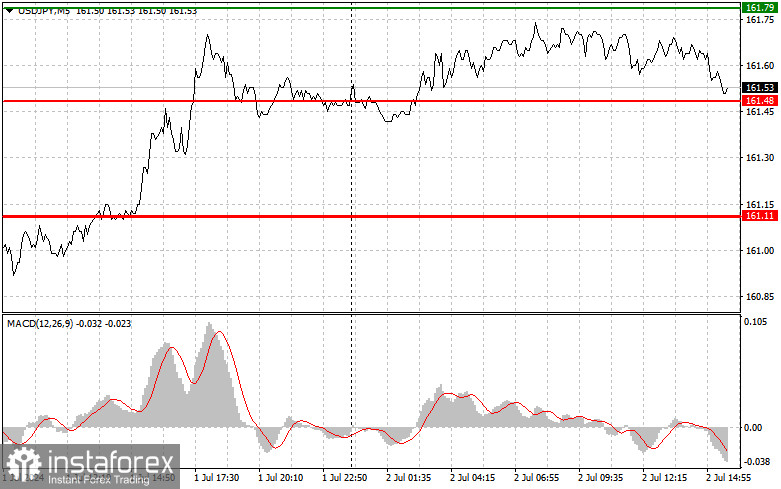Analysis of Trades and Tips for Trading the Japanese Yen
The designated levels I mentioned in the first half of the day were not tested, so I didn't find suitable entry points. Considering how cautiously traders act around the yearly high, the risk of intervention by the Bank of Japan cannot be ruled out. In the second half of the day, statements by Federal Reserve Chair Jerome Powell might provoke another yen sell-off and strengthen the US dollar, further developing the upward trend, so be prepared for this. If this does not happen, sellers can build a downward correction and trap the pair in a sideways channel. As for the intraday strategy, I plan to act based on the implementation of scenarios #1 and #2.

Buy Signal
Scenario #1: I plan to buy USD/JPY today upon reaching the entry point around 161.70 (green line on the chart) with a target of rising to 162.06 (thicker green line). Around 162.06, I will exit the purchases and open sales in the opposite direction (expecting a movement of 30-35 points in the opposite direction from this level). You can count on the pair rising today to continue the upward trend, but only after strong US data. Important! Before buying, ensure the MACD indicator is above the zero mark and just starting to rise from it.
Scenario #2: I also plan to buy USD/JPY today in case of two consecutive tests of the 161.48 price level when the MACD indicator is in the oversold area. This will limit the pair's downward potential and lead to a market reversal upward. Growth to the opposite levels of 161.70 and 162.06 can be expected.
Sell Signal
Scenario #1: I plan to sell USD/JPY today after the level of 161.48 (red line on the chart) is reached, leading to a rapid decline in the pair. The key target for sellers will be the level of 161.12, where I will exit the sales and immediately open purchases in the opposite direction (expecting a movement of 20-25 points in the opposite direction from this level). The pressure on the pair will return in case of an unsuccessful attempt to reach the daily high and weak US statistics. Important! Before selling, make sure the MACD indicator is below the zero mark and just starting its decline from it.
Scenario #2: I also plan to sell USD/JPY today in case of two consecutive tests of the 161.70 price level when the MACD indicator is in the overbought area. This will limit the pair's upward potential and lead to a market reversal downward. You can expect a decline to the opposite levels of 161.48 and 161.12.
What's on the chart:
Thin green line – the entry price at which you can buy the trading instrument.
Thick green line – the estimated price where you can set Take Profit or manually lock in profits, as further growth above this level is unlikely.
Thin red line – the entry price at which you can sell the trading instrument.
Thick red line – the estimated price where you can set Take Profit or manually lock in profits, as further decline below this level is unlikely.
MACD Indicator. When entering the market, it is important to be guided by overbought and oversold zones.
Important. For novice forex traders, making entry decisions very carefully is crucial. It is best to stay out of the market before important fundamental reports are released to avoid sudden exchange rate fluctuations. If you decide to trade during news releases, always set stop orders to minimize losses. You must set stop orders to avoid losing your entire deposit, especially if you do not use money management and trade in large volumes.
And remember, for successful trading, you need to have a clear trading plan, like the one presented above. Making spontaneous trading decisions based on the current market situation is initially a losing strategy for an intraday trader.
 English
English 
 Русский
Русский Bahasa Indonesia
Bahasa Indonesia Bahasa Malay
Bahasa Malay ไทย
ไทย Español
Español Deutsch
Deutsch Български
Български Français
Français Tiếng Việt
Tiếng Việt 中文
中文 বাংলা
বাংলা हिन्दी
हिन्दी Čeština
Čeština Українська
Українська Română
Română

